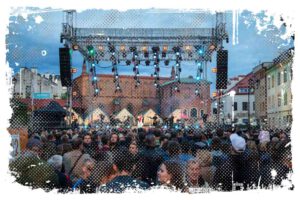Let me start by saying something you already know – Floriańska Street is the star attraction of Krakow. And why not? It’s got a story stretching back to the thirteenth century. It was laid out to lead from the St. Florian church to Wawel, giving it its name. Being there, you need to know it was one of the first streets in the city to be paved. Imagine, it even hosted a horse-drawn tram line in the late 1800s, later electrified, but barely squeezing through the Florian Gate.
Floriańska Street – The Wonders of Kraków
The history of Floriańska Street didn’t stop there. Part of the illustrious Royal Route, along with Grodzka Street and the Main Market Square, it saw the grand procession of royal coronations and funerals. Yes, kings and queens have graced this street!

I can tell, the buildings lining the street have evolved over time. But that doesn’t mean they’ve lost their historical charm. In fact, they each tell a part of Floriańska Street’s story. At number 45, there’s Jama Michalik, and the home of Jan Matejko waits at number 41. The Museum of Pharmacy, run by the Jagiellonian University, is nestled in house number 25.
- Here is the list of most important museums you should visit: Top 13 Must-See Museums in Krakow – You Private Guide
Floriańska Street in The Past
Continuing your stroll down Floriańska Street, the oldest hotel in the city, Pod Różą, welcomes you at number 14. Make sure to admire the late Renaissance statue of Madonna with Child at tenement house number 7. And if you want a taste of royal grandeur, the triumphal arch commemorating coronations stands next to the „Pod Murzynami” tenement house at number 1.
↳ Make sure to read my guide to the most amazing places to stay in Kraków:
How to Find Best Place to Stay in Krakow Old Town – Your Guide
Floriańska Street – A Royal Route
I believe it’s worth saying that Floriańska Street was always one of the key routes in Krakow. Outlined during the city’s Great Location in the thirteenth century, it became a critical part of the Royal Route. The cobbled street was a statement of grandeur, and by the end of the fifteenth century, most of the homes along Floriańska Street were constructed from bricks.

Even with many structures undergoing renovations, especially during the nineteenth and twentieth centuries, several elements have endured. Notable examples include house No. 3 with a striking Renaissance portal, and No. 5 and No. 8 featuring late-Gothic portals. No. 7 houses an early Renaissance statue of the Virgin Mary with similarly styled portals, while No. 9 and No. 26 boast of Renaissance portals.
And then there’s No. 17 – its facade is adorned with a piece of chain, a remnant of times when streets were closed at night. Imagine the stories these streets could tell if they could talk!
- I suggest you also read this article about past times in Kraków: Krakow Ghetto – A Journey Through the Shadows of World War II
Let me tell you about some of the gems hiding in plain sight on Floriańska Street. Starting with house No. 14, there’s Pod Różą, the oldest hotel in the city. It’s been around since 1800, initially named „de Russie” to honor the visit of Grand Duke Konstantin and Tsar Alexander I.
Even the great composer Franz Liszt called this place home while in Krakow. However, despite what the plaque might tell you, famed French writer Honoré de Balzac never stayed here. He was a guest at one of the cheaper inns on Stradom.
This magnificent building dates back to the fourteenth century. It’s been through some changes, but what catches the eye is the late Renaissance portal gracing its façade, bearing a beautiful Latin inscription wishing the house eternal life. Can you picture that scene?
House of the Legendary Jan Matejko
Don’t miss house No. 41. Once the abode of Jan Matejko (1837-1893), it’s now a museum dedicated to this renowned Polish historical painter. Matejko was born and died in this narrow tenement. I am convinced that the memorabilia, docments, photos, goldsmith works, numerous paintings, and sketches displayed here will captivate you.

There’s even an eerie collection of executioner’s tools excavated from the Town Hall dungeons. The building’s façade, designed by Tomasz Pryliński, is an early example of neo-baroque architecture, quite rare in Krakow (1873).
Poland’s Largest Museum of Pharmacy
Further down the street, house No. 25 is home to the largest Museum of Pharmacy in Poland, one of the few worldwide, run by the Jagiellonian University. Lawyer and collector Stanisław Proń, from a family of Krakow pharmacists, founded it in 1946.

The museum boasts exhibits from over 1200 pharmacies across Poland. Among its highlights are recreations of historic pharmacy interiors from the sixteenth to seventeenth centuries, and the Empire, Biedermeier, neoclassical, and neo-baroque styled pharmacies. A special room replicates the office of kerosene lamp inventor Ignacy Łukasiewicz, featuring a collection of nineteenth-century lamps.
Michalik’s Cave (Jama Michalika) – Artistic Heritage
Lastly, house No. 45 holds a special place in Krakow’s cultural heritage. Once a confectinery opened by Jan Michalik, a confectioner from Lviv, in 1895. It was the birthplace of the first literary and artistic cabaret in Poland, „Zielony Balonik”.

Founded by Krakow artists and writers associated with the Young Polish trend, it held performances here from 1905 to 1912. With no windows, artists dubbed it Jama Michalik („Michalik’s Cave”), a name that’s stuck around to this day.
Inside, you’ll find walls decorated with paintings by Karol Frycz and drawings and caricatures by Young Poland artists. Look for the nativity scene puppets displayed in the showcases, once exhibited by the cabaret. Talk about stepping back in time!
References:
- https://wiadomosci.onet.pl/kraj/ulica-florianska-w-krakowie-najwazniejsze-informacje/84r9wsp
- https://mapa.targeo.pl/florianska-ul/krakow-31-019/ulica
- https://pl.wikipedia.org/wiki/Ulica_Floria%C5%84ska_w_Krakowie
- https://www.krakow.pl/instcbi/11195,inst,4858,306,instcbi.html




